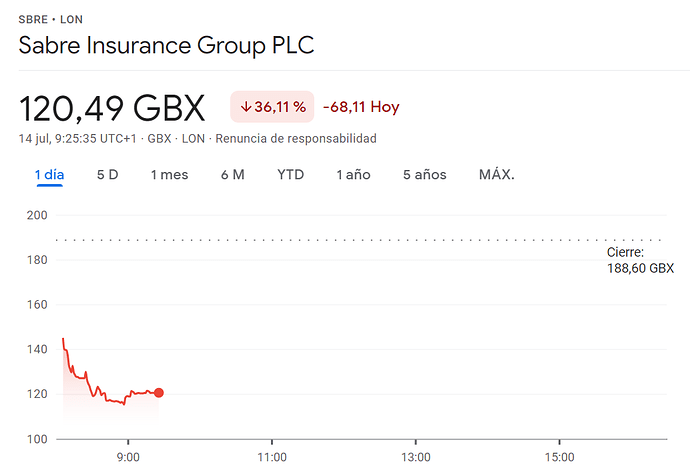La galleta de hoy a que se debe?
A punto de reemplazar a Imperial Brands como peor posición de la cartera GBP
Llevo un tiempo mirando esta y sorprende que cada vez que se mete un batacazo cae un -15% en un día. Ayer no me pude resistir y entré por primera vez, ya cerca del -7% desde entonces. Si llega al -10-15% va a ser duro aguantar la diversificación temporal ![]()
Está todo el sector asegurador europeo entre flojo y peor.
Otro jamón con gusanos en el horizonte
Ha entrado en modo “falling knife” total
El 10 de agosto presenta resultados de la primera mitad del año… demasiados días aún…
Lo cierto es que viendo la caída y el dividendo entran ganas de meterle.
El mismo precio que hace 5 años pero con un 25% mas de vehículos asegurados
Caída del 40% en un año (la compañía no puede valer un 40% menos en ese periodo. salvo que estuviera sobre valorada en tanto y ademas tiene un PER decente actualmente)
Dividendo por encima del 8% a los precios actuales.
Entran ganas de ser valiente cuando todo el mundo entra en pánico.
Llevo unos días pensando lo mismo @ironman.
Y acabaremos cayendo…
Lo de hoy la sido por el profit warning de Direct Line, ¿no?
Eso y downgrade de Jefferies
Yo pensaba que había sido por el profit warning de Sabre Insurance la semana pasada.
La acción bajo de 189 a algo así como 117 el jueves o el viernes. Y hoy anda cercano a los 100 lo que es una caída del 40% aproximadamente en 5 días.
Al parecer el margen ha caído cerca del 80% debido a la subida de los costes en las reparaciones asumidas por los seguros.
Otras aseguradoras han visto un squeeze grande de los márgenes por el alto coste de las reparaciones.
Al final creo que eso se ajusta a largo plazo ya que los seguros acabaran subiendo los precios para compensar los costes pero a corto plazo puede ser un problema grande con lo que parece que antes de comprar será mejor esperar a su release y luego pensar si puede ser una buena inversión a largo plazo o no.
Yo voy ya cargado de Mapfre y Linea directa (sobre todo Mapfre que se esta viendo afectada también por las malas noticias del sector asegurador aunque Mapfre tiene un negocio mas diversificado).
La pregunta es si el sector da la oportunidad no es mejor hacerlo en Mapfre a 1,50 o 1,45 que hacerlo en Admiral…no lo se. Esperemos…, no hay prisa. Mi impresión es que aun vamos a ver cosas y oportunidades que hoy nos parecen baratas y que aun les queda recorrido a la baja.
Efectivamente, yo también tengo la sensación de que podemos ver precios mejores en el sector durante este verano, pero como no tengo la certeza, y esta la tenía en mi lista de la compra, hoy he hecho una pequeña entrada (1/3 del objetivo).
También voy cargado de Mapfre (7,5% de mi cartera), y no me preocupa la cotización mientras mantenga el dividendo.
Qué le veis a Admiral que no tenga Legal and General? Esta última tiene un dividendo parecido y no tiene estos vaivenes en su cotización…
Tengo Legal & General, se puso a tiro y compre unas cuantas. Contento con ello.
Ahora simplemente viendo si Admiral puede ser una oportunidad o un marrón.
Son dos sectores y negocios distintos.
Viendo la mini subida de hoy me ha entrado el FOMO y he comprado a 17.85£
